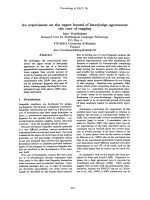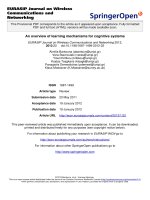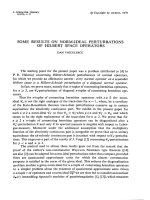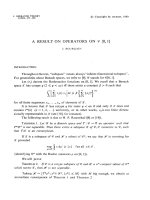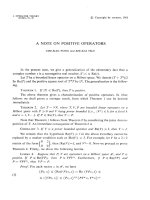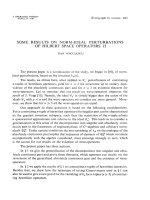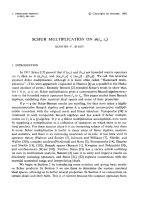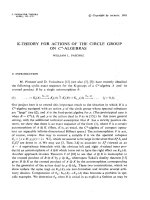Báo cáo toán học: "An introduction on below-ground environment and resource acquisition, with special reference on trees. Simulation models should include plant structure and function" potx
Bạn đang xem bản rút gọn của tài liệu. Xem và tải ngay bản đầy đủ của tài liệu tại đây (86.8 KB, 8 trang )
Original article
An introduction on below-ground environment
and resource acquisition,
with special reference on trees. Simulation models
should include plant structure and function
Loïc Pagès
a,*
, Claude Doussan
b
and Gilles Vercambre
a
INRA, Centre d’Avignon,
a
Écophysiologie et Horticulture, 84914 Avignon Cedex 9, France
b
Science du Sol, Site Agroparc, 84914 Avignon Cedex 9, France
(Received 1 February 1999; accepted 12 July 1999)
Abstract – Resource acquisition within the soil is a complex process, which consists of several sub-processes involving both the soil
and the plant. A brief analysis of the whole system is presented, first by focusing on the components of the system, and then on the
successive events. This analysis stresses the diversity and specificity of the components involved, as well as their interactive roles, at
several organisation levels, both in space and time. Therefore, a systemic approach using dynamic models is defended in order to
gather available knowledge and gain new insight within the whole system. In comparison to many of the traditional modelling
approaches, which tended to over-simplify the plant part of the system, some new and promising attempts are presented. These new
models give a good illustration of what can be expected to be gained by associating structural and functional characteristics of the
plant components.
model / root system / soil – plant system / uptake
Résumé – Introduction sur l’environnement souterrain et l’acquisition des ressources, avec références particulières aux
arbres. Les modèles de simulation devraient inclure la structure et les fonctions de la plante. L’acquisition des ressources du sol
est un processus complexe, que l’on peut subdiviser en plusieurs processus plus élémentaires faisant intervenir conjointement la plan-
te et le sol. Nous faisons une brève analyse de ce système, en insistant d’abord sur ses composants, puis sur les événements succes-
sifs. Cette analyse révèle la diversité et la spécificité des composants impliqués, ainsi que leurs rôles interactifs, à plusieurs niveaux
d’organisation dans le temps et dans l’espace. Aussi, nous défendons une approche systémique, utilisant la modélisation dynamique,
pour synthétiser les connaissances disponibles, et obtenir ainsi un nouvel éclairage sur le système pris dans sa globalité. En comparai-
son avec les approches de modélisation traditionnelles, qui tendent à simplifier outrageusement la partie plante du système, nous pré-
sentons quelque démarches nouvelles et prometteuses. Ces derniers modèles illustrent bien les progrès que l’on peut escompter en
associant davantage les caractéristiques structurales et fonctionnelles des composants de la plante.
absorption / modèle / système racinaire / système sol – plante
Ann. For. Sci. 57 (2000) 513–520 513
© INRA, EDP Sciences
* Correspondence and reprints
Tel. 04 90 31 60 65; Fax. 04 90 31 60 28; e-mail:
L. Pagès et al.
514
1. INTRODUCTION
Resource acquisition within the soil is a complex
process, which involves several sub-processes occurring
both in the soil and in the plant. Our aim is not to make
here an exhaustive tour on this very large subject, on
which several more specialised reviews have been writ-
ten (e.g. [9] and [19], on water uptake; [1] and [12], on
nutrient uptake).
Here we intend giving a short introduction to the sub-
ject, from a certain point of view, and with particular
emphasis on trees. For this purpose, we make a brief
analysis, presenting firstly the different actors of the play
with their major specific characteristics, and secondly
the scenario, by considering the main steps in water and
nutrient movement in the soil and the plant.
In the second part, we focus on the modelling require-
ments for the staging, i.e. for getting an integrated repre-
sentation of the whole system, by giving to each actor its
specific interactive role in the whole system.
For investigating such complex systems, dynamic
models are useful tools. It is worth noting that models
have been used for many years in this domain, at least
since 1960 (see for example the review from Barber [1]).
However, most of the models have almost completely
neglected the representation of the plant and its root sys-
tem. This may be because they have been developed
mainly by soil physicists, and because of the difficulties
related to the observation and representation of the root
system. In order to improve such models, with the objec-
tive to give more precise answers on when, where, and
how much uptake occurs, it is necessary to include a
more detailed model of the plant (and especially the root
system) structure and function. Through some examples
of recent work, we shall see how the representation of
the structure-function variations within the root system
can modify our quantitative approach to resource acqui-
sition.
2. THE ACTORS
2.1 Resources
Resources which are taken from the below-ground
environment are numerous, and diverse. The first impor-
tant distinction is between water and mineral nutrients,
whose properties are very different. Water is the support
or the vector for ions. Ions can move with water by mass
flow, or by diffusion.
Considering diffusion, it is important to note that
large differences exist in ion mobility, depending mainly
on their interaction with the solid phase of the soil.
These differences lead to the definition of an apparent
diffusion coefficient, with variations greater than 2
orders of magnitude, between mobile ions, such as
nitrate, and immobile ones, such as phosphate [14].
The requirements of the plant concerning these
resources are also very variable (e.g. macro versus
micro-nutrients), and they are more or less buffered,
especially in trees, where reserves can play an important
role. For instance, there are almost no reserves for water,
allowing to buffer only the daily requirements, while
reserves for nitrogen can give weeks to months of
buffering capacity [18].
These multiple resources interact. An example is
given by water, whose content in soil influences both the
intensity of mass flow, and the apparent diffusion coeffi-
cient for the different ions within the soil.
One of the most important aspects when considering
these resources is their heterogeneous distribution, with
steep spatial gradients, and strong temporal variations.
For water especially, its availability can vary greatly
with depth, especially in the surface layers after a dry
period. This state is not permanent, since the water pro-
file can be suddenly inverted, just after a significant rain,
which will lead to a decrease in water availability with
depth. Distribution of nutrients also presents such varia-
tions. They often concentrate at the soil surface, and
show considerable variations in the horizontal plane (100
to 400% for NO
3
, NH
4
, PO
4
, according to Jackson and
Caldwell [13]). This heterogeneous distribution – and
thus availability – both in space and time is not specific
to natural ecosystems, it may also be reinforced by vari-
ous cultural techniques, such as fertiliser application or
drip fertirrigation (fruit trees). Heterogeneity also exists
on a small scale, with, for instance, local enrichments
around decomposing organic structures [23], and deple-
tion around functioning roots [14].
2.2 Soil
As soil is the containing system for resources, its
properties are of prime importance, especially through its
interactions with water and nutrients. The hydro-dynam-
ic characteristics of the soil (water release curve,
hydraulic conductivity) are known to be highly impor-
tant variables for the water uptake process. Concerning
interactions with nutrients, the soil’s buffering capacity
is also an important characteristic, since together with
local nutrient concentrations, it defines the dynamics of
the local availability of nutrients.
The soil also interacts with the root system. It influ-
ences its development, structure, and functioning.
Below-ground environment and resource acquisition
515
Temperature, bulk density, and oxygen availability are
characteristics of the soil which are of major importance
in these development and acquisition processes. These
three variables present spatial heterogeneity that primari-
ly determine root growth rate, and also the movement of
resources and their uptake rate, since nutrient uptake is
an energy-dependent process primarily relying on tem-
perature and oxygen availability within the soil.
Local availability of nutrients is also determined by
the biological and chemical activity localised in the rhi-
zosphere. For example, soil micro-organisms, interacting
with the roots, play an important part in nutrient mobili-
sation [12].
2.3 Plant and root systems
Even though it seems obvious to say that the plant and
the root system play a major role in the acquisition
processes, the representation of the plant and root com-
plex as an uptake system has often been neglected [5].
From a geometrical point of view, the root system
defines both the potential uptake volume (through its
global extension) and the minimal distance from the
resource to the root (root density). In addition, the root
system presents a number of physiological characteris-
tics affecting uptake.
The characteristics of the root system have often been
described using root profiles, which consider variation of
root length density versus depth. This type of representa-
tion assumes more or less implicitly that the spatial dis-
tribution of roots is homogeneous within each horizontal
soil layer, that all the roots are identical, and that root
connections and transport pathways can be neglected.
These simplifications are particularly difficult to assume
in most cases, and especially for tree root systems
because of the structural characteristics of their root sys-
tems. Botanists who have studied tree root systems have
on the contrary emphasised the diversity of roots (called
heterorhizy), and the high organisation of the root sys-
tems [8].
Heterorhizy, which can be defined as the heterogene-
ity of roots in the root system, concerns many
morphological and anatomical criteria which also have
functional significance in relation to uptake. For exam-
ple, the apical diameter of roots can vary by more than
one order of magnitude in peach trees [31]. These varia-
tions in the apical diameter are associated with high vari-
ations in water conductance and radial growth [30].
Mycorhizae can be considered as extending the diversity
of roots within the root system.
In addition to between-root variations, ontogenetic
gradients exist along the roots [17, 33]. Recent studies
show that the uptake and conductance characteristics of
the roots vary greatly according to the position along the
root [3, 4, 10, 26]. The distal parts of roots present gen-
erally high radial permeability and uptake capacity com-
pared to the older proximal parts. These older parts have
generally much higher conducting capacities. These vari-
ations may reach several orders of magnitude.
Moreover, these variations are not randomly distrib-
uted in space, as expected if one considers the organised
morphogenetic programme of the plant. The develop-
mental scheme, as well as the connection constraints
within the plant, lead to a spatial structure. Roots tend to
be clustered in space (e.g. [22]), and young root tips
especially tend to be located at particular sites within the
whole architecture. Conversely, it is clear that roots that
are either woody or old tend to be grouped near the stem,
making the stump structure. Spatial clustering of roots
has important consequences on water uptake, as shown
by Tardieu et al. [27].
In addition to this architectural heterogeneity of the
root system, the whole plant functioning also influences
the dynamics of water and nutrient uptake, and its distri-
bution within the root system. For instance, the restric-
tion in the availability for carbohydrates can influence
the temporal pattern of nutrient uptake, and its between –
root distribution. For example, Thaler and Pagès [28]
have shown that the fine roots are more sensitive to car-
bohydrate restrictions than the large ones.
3. THE SCENARIO
Another complementary point of view that can be
developed on resource acquisition deals with the sce-
nario, i.e. the sequence of events which occurs during the
whole process. Three different phases can be distin-
guished, involving the different actors. During the first
phase resources reach the root surface (supply to the root
surface), either by their own movement or because of
root growth. During the second phase resources pass
from the root surface into the xylem vessels (uptake
sensu stricto). The third phase sees resources transported
within the plant and assimilated, either in the root or the
shoot system (transport and assimilation).
3.1 Supply to the root surface
The result of this first important phase, which occurs
exclusively within the soil, is the meeting between the
resource and the absorbing root.
Root growth is very important regarding the foraging
of the soil resources, especially for the less mobile ones.
L. Pagès et al.
516
Growth is dependent on soil characteristics, which are
more or less favourable (e.g. temperature, oxygen avail-
ability, mechanical impedance), and also on root type
(heterorhizy) since, in the same medium, some roots can
grow up to several cm per day while others will exhibit a
much lower growth rate and a short growth duration (e.g.
[16]).
Water transport is related to the hydro-dynamic char-
acteristics of the soil (water release curve, and hydraulic
conductivity) and depend on the soil texture, structure,
and water content. The hydraulic conductivity can exhib-
it a steep decrease, up to several orders of magnitude, so
that water transport in the soil becomes probably the
major bottleneck of resource acquisition in dry soils,
reinforcing the drought effect. Nutrient transport can be
achieved by the two concurrent processes of diffusion
and mass flow. The balance between these mechanisms
depends on the resource and on the water regime during
the growing season. An example is given in table I for a
standard maize crop (from Barber [1]).
The gradients of water and nutrient availability
around the roots constitute the main driving force for
their movement. Here is the link with the second step.
3.2 Uptake sensu stricto
Water uptake is generally considered as passive, due
to water potential gradients between the external and
internal medium. In this physical formalism, which is
generally accepted, the proportionality coefficient
between the flux and the gradient is the radial conduc-
tance. This radial conductance varies with differentiation
and ageing of tissues along the root (review by Moreshet
and Huck [20]).
For nutrients on the contrary, uptake is generally con-
sidered as selective and active, since uptake occurs
against the concentration gradient. It requires trans-
porters and energy, whose availability depend on the
plant nutrient status, the root type, and on the ontogenet-
ic gradient along the root. On avocado trees for instance,
Waisel and Eshel [32] have shown strong variations
(twofold to tenfold) between- and along-root, for potassi-
um and sodium uptake, in the most apical 5 cm of the
roots.
3.3 Transport and assimilation
During this third step, water and nutrients are trans-
ported and used (either assimilated, or evaporated).
Since most of the transport occurs in the xylem ves-
sels, its resistance network is of prime importance. The
variations of axial resistance in the root system of peach
trees have been shown to be highly correlated to the
diameter variations of roots ([30] figure 1). Radial
growth, which is the major process by which roots can
increase their axial conductance in dicotyledonous
species, seems to be highly co-ordinated within the root
systems. It results in close relationships between the root
sections of mother roots and the sum of root sections of
their daughter roots ([25, 29, 30] figure 2).
The use of the absorbed products is also an important
process to consider, since it modifies the plant status and
so the plant demand. For water, the storage capacities are
very low. The amount of water stored in peach trees and
used during the day reaches only 10% of the total daily
Table I. Relative importance of the different processes leading
to resource supply to the root in the case of a maize crop (after
Barber, 1984).
Nutrient Amount need Interception Mass flow Diffusion
N 190 2 150 38
P401237
K 195 4 35 156
Ca 40 60 150 0
All data in kg/ha.
Figure 1. Variations of axial water conductance versus diame-
ter in peach tree roots (after [30]).
Below-ground environment and resource acquisition
517
transpiration [24]. For nutrients, the definition of plant
status is far more complex since it is related to growth
dynamics and storage capacities which can be much
more important.
Finally, we would like to underline that even though a
distinction could be made between these 3 successive
processes of resource acquisition, their interactions
should be kept in mind, and needs to be modelled. Thus,
the distribution of entering water and nutrient fluxes is
not fixed. It is a dynamic field, resulting at each moment,
of: the distribution of resource availability in the soil; the
root system development through the alteration of its
geometrical, topological, and ontogenetic characteristics;
and the fluctuation of the plant demand propagated
through its uptake sites. The possible adaptation of the
plant to a heterogeneous environment has been shown by
many observations and experiments. Among them, Drew
and Saker [7] showed both the morphological and func-
tional plasticity of barley plants cultivated in several lay-
ers of nutrient solution, containing or not containing
nitrate. Not only the lateral roots grew faster and were
more branched in the enriched layers, but their uptake
rate also increased, resulting in a globally optimised
uptake system.
4. THE STAGING
Dynamic simulation models are necessary tools for
the staging, or for synthesising the knowledge about
these components interacting through multiple processes,
in order to get prediction or new insights concerning the
whole complex system. To simplify, we have distin-
guished what we call the “classical models”, which have
been developed from 1960 onwards (e.g. [1, 9, 11, 19,
21]), and more recent approaches, which integrated the
plant structure and function to a greater extent.
4.1 Classical models
Detailed reviews have been made about these “classi-
cal models”, devoted to water uptake [9, 19] or nutrient
uptake [1]. Even if they differ in their design, because
they are associated to various objectives and plants,
these models share a common feature: the over-simpli-
fied representation of the plant and its root system. Most
of these models have focused on the soil and resource
components, considering only the first step of the global
process: the supply to the root via the water and nutrient
transport. The roots are represented relative to the soil,
using a soil-related variable, the root length density. This
synthetic variable tries to quantify merely the colonisa-
tion of the soil layer.
It is important to note that this approach has been
developed mainly for annual crops, and particularly cere-
als and grasses, which have a particular strategy of root
growth characterised by dense and continuously re-
colonising root systems. For tree ecosystems, the prob-
lem differs greatly, since trees (at least dicotyledonous)
are much larger and at the same time their root system is
less dense, presenting also a typical heterorhizy.
Therefore, the assumption of an homogeneous and undif-
ferentiated root length density is no longer acceptable for
tree ecosystems.
4.2 Structure-function models
Some attempts have been made recently to improve
the uptake models, especially for water uptake, by
including a more realistic representation of the plant.
The non-uniform distribution of roots in soil was con-
sidered by Lafolie et al. [15] who proposed a two-dimen-
sional water flow model for a set of unevenly distributed
roots. In this case, the root water potential was assumed
to be uniform throughout the root system.
Later on, Clausnitzer and Hopmans [2] suggest merg-
ing a whole plant model describing the detailed three-
dimensional architecture of the root system, with a soil
water flow model. Root water uptake is represented by a
three-dimensional sink function, calculated from the root
tips locations, and assuming that only root tips are active
Figure 2. Relationship between the root section area between
mother and daughter roots in peach tree root system (after
[30]).
L. Pagès et al.
518
in the uptake. The dynamics of the plant demand is also
taken into account and shared between the roots.
To circumvent the arbitrary hypothesis that the water
potential is uniform within the root system, or that only
root tips absorb water, Doussan et al. ([5] and [6]) sug-
gested modelling the hydraulic architecture of the root
system. This model merges the architectural modelling
of the root system with a hydraulic model, considering
radial and axial water conductances at the root segment
level (figure 3). With this formalism and particular con-
ductance data, it is possible to model the distribution of
water potentials and fluxes within the root system, for a
given set of external conditions. For example, using con-
ductance data of peach trees, Vercambre et al. [30] could
quantify the water potential gradients as well as the local
fluxes in the root system. This model illustrates how
structural and functional information can be merged on a
local scale, in order to give a global functioning scheme
which cannot be inferred without such a model.
5. CONCLUSION
Acquisition of resources within the soil environment
is a complex process, because it involves a network of
interactions between multiple components. These com-
ponents have specific behaviours, which need to be mod-
elled in order to preserve the integrity of the global
Figure 3. Distribution of the water potential in the peach tree root system, as calculated by a hydraulic model of the root system [5].
Data concerning the water conductance are from Vercambre et al. [30].
Below-ground environment and resource acquisition
519
system. Thus, models should mix different formalisms,
for representing at the same time physical processes (e.g.
Darcy’s law) and biological ones (e.g. root growth).
These models should also succeed in the integration
of several organisation levels, from the plant level (e.g.
nutrient status) to the root tip level (e.g. uptake charac-
teristics), and several time scales (e.g. day for water,
week or month for some nutrients).
For different reasons, such as the search for simplici-
ty, the selection of the major limiting processes in partic-
ular situations, or the limited programming and calcula-
tion power, models have focused on a limited part of the
system, namely the soil. In the future, considerable
progress in modelling the resource acquisition can be
expected from a better consideration of the plant.
Including the plant in these models means including
global functional processes, and also its local character-
istics, especially the specific architecture of the acquisi-
tion system. Many recent works have been done which
concern both this architecture and its local functional
characteristics.
REFERENCES
[1] Barber S.A., Soil Nutrient Bioavailability: A
Mechanistic Approach. 2nd ed. John Wiley & Sons,
New York, 1984.
[2] Clausnitzer V., Hopmans J.W., Simultaneous modeling
of transient three-dimensional root growth and soil water flow,
Plant Soil 164 (1994), 299-314.
[3] Cruz C., Lips S.H., Dartins-Lonçao M.A., Uptake
regions of inorganic nitrogen in roots of seedlings,
Physiol. Plant. 95 (1995) 167-175.
[4] Clarkson D.T., Sanderson J., Russel R.S., Ion uptake and
root age, Nature 220 (1968) 805-806.
[5] Doussan C., Pagès L., Vercambre G., Modelling the
hydraulic architecture of root systems: An integrated approach
of water absorption. I. Model description, Ann. Bot. 81 (1998)
213-223.
[6] Doussan C., Vercambre G., Pagès L., Modelling the
hydraulic architecture of root systems: An integrated approach
of water absorption. II. Distribution of conductances and con-
sequences, Ann. Bot. 81 (1998) 225-232.
[7] Drew M.C., Saker L.R., Nutrient supply and the growth
of Barley. II. Localized, compensatory increases in lateral root
growth and rates of nitrate uptake when nitrate supply is
restricted to only part of the root system, J. Exp. Bot. 26 (1974)
79-90.
[8] Eshel A., Waisel Y, Multiform and multifunction of var-
ious constituents of one root system, in: Plant roots, the hidden
half 2nd Ed Waisel Y, Eshel A., Kafkafi U. (Eds.). Deker,
New-York, 1996, pp. 175-192.
[9] Feddes R.A., Kabat J.T., Bronswijk J.J.B., Halbertsma
J., Modelling soil water dynamics in the unsaturated zone,
State Art. J. Hydrol. 100 (1988) 69-111.
[10] Frensch J., Hsia T.C., Steudle E., Water and solute
transport along developing Maize roots, Planta 198 (1996) 69-
111.
[11] Gardner W.R., Dynamic aspects of water availability to
plants, Soil Sci. 89 (1960) 63-73.
[12] Hinsinger P., How do plant roots acquire mineral nutri-
ents? Chemical processes involved in the rhizosphere, Adv.
Agron. 64 (1998) 225-265.
[13] Jackson T.C., Caldwell M.B., Modeling the root water
potential and soil-roots water transport in the two-dimensional
case. I. Presentation of the model, Soil Sci. Soc Am. J. 55
(1993) 1203-1212.
[14] Jungk A., Dynamics of nutrient movement at the soil-
root interface, in: Plant roots. The hidden half 2nd Ed. Waisel
Y., Eshel A., Kafkafi (Eds.). Marcel Dekker, Inc., New-York,
1996, pp. 529-556.
[15] Lafolie F., Bruckler L., Tardieu F., Modeling the root
water potential and soil-roots water transport in the two-dimen-
sional case. I. Presentation of the model, Soil Sci. Soc Am. J.
55 (1991) 1203-1212.
[16] Le Roux Y., Pagès L., Développement et polymor-
phisme racinaire chez de jeunes semis d’hévéa (Hevea
brasiliensis), Can. J. Bot. 72 (1994) 924-932.
[17] Lüttge E., Klugge M., Bauer G., Botanique. TecDoc
Paris, 1992.
[18] Millard P., Ecophysiology of the internal cycling of
nitrogen for tree growth. Z. Planzenernähr., Bodenk. 159
(1996) 1-10.
[19] Molz F.J., Models of water transport in the soil-plant
system: A review, Water Resour. Res. 23 (1981) 1346-1356.
[20] Moreshet S., Huck M.G., Dynamics of water perme-
ability, in: Plant roots. The hidden half. Waisel Y., Eshel A.,
Kafkafi (Eds.), Marcel Dekker, Inc., New-York, 1991, pp. 605-
626.
[21] Nye P.H., Marriott F.H.C., A theoretical study of the
distribution of substances around roots resulting from simulta-
neous diffusion and mass flow, Plant Soil 3 (1969) 459-472.
[22] Pellerin S., Pagès L., Evaluation in field conditions of a
three-dimensional architectural model of the maize root sys-
tem: comparison of simulated and observed horizontal root
maps, Plant Soil 178 (1996) 101-112.
[23] Robinson D., The responses of plants to non-uniform
supplies of nutrients, New Phytol. 127 (1994) 635-674.
[24] Simonneau T., Habib R., Goutouly, J P., Huguet J G.,
Diurnal changes in stem diameter depend upon variations in
water content: direct evidence in peach trees, J. exp. Bot. 44
(1993) 615-621.
[25] Spek L.Y., Van Noordwijk M., Proximal root diameter
as predictor of total root size for fractal branching. II.
Numerical model, Plant Soil 164 (1994) 119-127.
[26] Steudle E., Peterson C.A., How does water get through
roots? J. exp. Bot. 49 (1998) 775-788.
L. Pagès et al.
520
[27] Tardieu F., Bruckler L., Lafolie F., Root clumping may
affect the root water potential and the resistance to soil root
water transport, Plant Soil 140 (1992) 291-301.
[28] Thaler P., Pagès L., Root apical diameter and root elon-
gation rate of rubber seedlings (Hevea brasiliensis) show paral-
lel responses to photoassimilate availability, Physiol. Plant. 97
(1996) 365-371.
[29] Van Noordwijk M., Spek L.Y., De Willigen P.,
Proximal root diameter as predictor of total root size for fractal
branching. I. Theory, Plant Soil 164 (1994) 107-117.
[30] Vercambre G., Doussan C., Pagès L., Habib R.,
Distribution of hydraulic conductance in peach tree root system,
Implication for water extraction, Plant Soil (1999) (submitted).
[31] Vercambre G., Pagès L., Architecture racinaire du
pêcher en conditions de verger. Utilisation d’un modèle pour
lier des observations statiques et simuler une dynamique de
mise en place, in: Architecture et modélisation en
Arboriculture fruitière, 11
e
Colloque sur les Recherches
Fruitières, INRA-CTIFL, Montpellier, 05-06/03/98, 1998,
pp. 286-292.
[32] Waisel Y., Eshel A., Differences in ion uptake among
roots of various kinds, J. Plant. Nutr. 15 (1992) 945-958.
[33] Wang X.L., McCully M.E., Canny M.J., The branch
roots of Zea. IV. The maturation and openness of xylem con-
duits in first-order branches of soil-grown roots, New. Phytol.
126 (1994) 21-29.
